The tragedy of Georgy Gapon
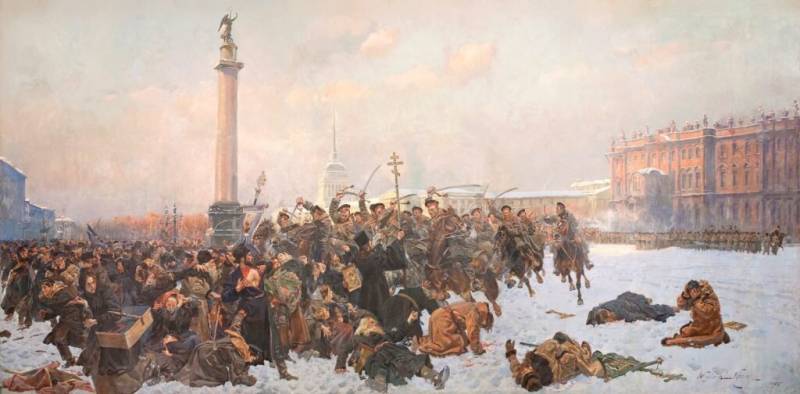
В previous article it was told about the origin and early life of Georgy Apollonovich Gapon, who quickly went from a modest graduate of the Poltava Theological Seminary to the leader of the workers of St. Petersburg.
We talked about his generally harmless and even useful cooperation with the Police Department, as well as his role in organizing a mass procession to the Winter Palace. Here, representatives of workers and peasants were supposed to hand over to Nicholas II a petition about the people's needs with a request for protection from the tyranny of capitalists and local officials.
However, as you remember, both the emperor himself and his entourage did not like this naive appeal to the “Tsar-Father”. And the attempt to ask Nicholas II for reforms was regarded as unheard of insolence, and the most reactionary members of the imperial family insisted on “exemplary punishment” for the “insolent people.”
The emperor’s uncle, Grand Duke Vladimir Alexandrovich, for example, demanded to “calm the unrest” by publicly hanging “several hundred dissatisfied people.” Representatives of the upper classes did not even want to hear about the true state of affairs in the empire. After all, it was the extremely unfair distribution of national wealth that allowed them to lead a “European lifestyle”: spend time at foreign resorts, spend mind-boggling sums in foreign gambling houses, brothels and taverns, support ballerinas and actresses, and luxuriously furnish their Russian estates and palaces. All these pleasures were paid for by the subjects of Nicholas II, whose standard of living was 3,7 times lower than in Germany and 5,5 times lower than in the USA.
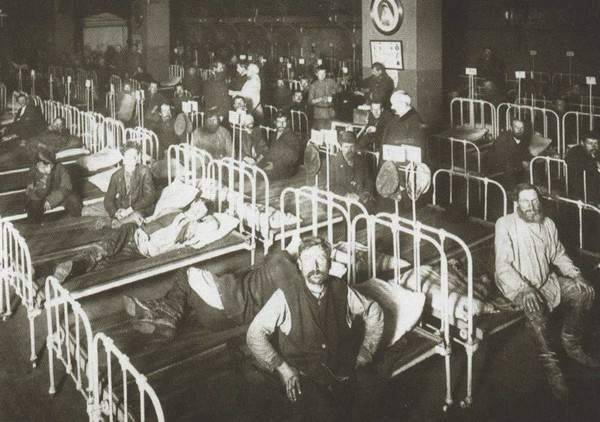
They even made money from peasants freed from serfdom, since according to the developed “Regulations...” all land remained the property of the landowners. Former serfs were allocated a “field allotment,” for which they had to pay quitrents or work as corvee labor. Peasants had to buy this land for 49 years at a rate of 6% per annum (the average loan rate in the country is 5%). At the same time, the land, which actually cost 544 million rubles, was valued at 897 million.
It is not surprising that the famous Manifesto of the “Tsar-Liberator” caused massive peasant unrest throughout the country, which had to be suppressed for two years with the participation of the army. Only on January 1, 1906, the frightened Nicholas II signed a decree reducing the redemption payments by 2 times, and the following year they were canceled.
But at the beginning of 1905, it seemed to Nicholas II and his entourage that Russia could continue to be controlled with the help of whips and whips. Meanwhile, the prestige of Nicholas II had already suffered a terrible blow after the tragedy of the coronation celebrations on Khodynka Field - and a gloomy prophecy was spreading among the people that the new emperor, “having started with Khodynka, will end with Khodynka.”
The dispersal of the peaceful procession of people who decided to turn to the king “for truth and justice” completely ruined the reputation of the last emperor. From that moment on, he lost his sacred status, and no one believed in the legend about the “good king and evil boyars” that had existed for many centuries.
From now on, the people will blame Nicholas II for all their troubles and misfortunes, and the smartest people from his circle will look gloomily at the future and predict disaster. And in 1910, A. Blok heard how the emperor’s favorite, Admiral Nilov, standing a few steps from him, said to other courtiers:
Bloody Sunday
This day, January 9, 1905, is described in detail, literally minute by minute, in numerous sources. There is no need to repeat ourselves; we will briefly talk only about the course of events and the behavior of the hero of the article - G. A. Gapon.
In the morning, there were up to 11 thousand people in 140 columns (according to the number of branches of the “Assembly of Workers of St. Petersburg”). They walked to Palace Square from the Narva and Nevskaya outposts, the Vyborg and St. Petersburg sides, from Vasilyevsky Island and from Kolpino - but did not know that the tsar had already left the Winter Palace. On their way, the marchers were attacked by troops. At the Trinity Bridge, the procession was shot by soldiers of the Pavlovsky Guards Regiment, and then the fleeing people were pursued by the lancers.
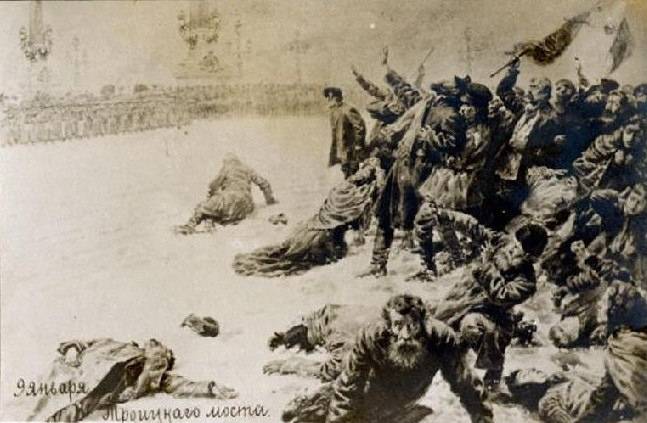
The demonstrators of the Nevsky branch on the Shlisselburg tract were attacked by the Cossacks of the Ataman regiment, but some of the workers moved towards the city center along the ice of the Neva River. Kolpino residents also reached Palace Square in small groups. Here, near the Alexander Garden, they were shot by soldiers of the Preobrazhensky Regiment.
The Semenovsky Life Guards Regiment attacked the march participants on Nevsky Prospekt. At the same time, contrary to the regulations, the order was given to open fire without warning. In August 1906, the commander of this regiment, General G. Min, was killed at the New Peterhof station by a member of the Combat Organization of the Social Revolutionaries Z. Konoplyannikova. Later, she was betrayed by the person who organized this terrorist attack - Yevno Azef.
Former rural teacher Zinaida Vasilievna Konoplyannikova became the first woman hanged in Russia by court verdict. It was she who turned out to be the author of the term “red terror”, declaring at the court hearing:
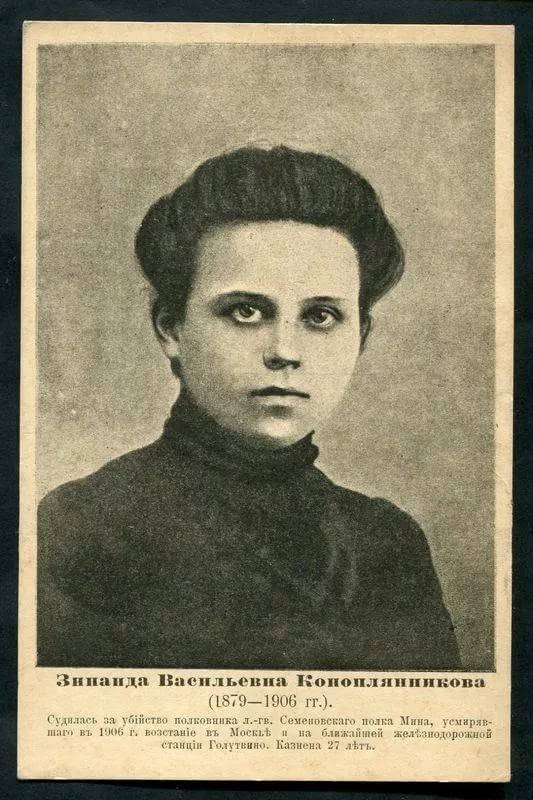
The Socialist-Revolutionaries also sentenced the commander of the 3rd battalion of this regiment, N. Riman, who especially “distinguished himself” during those events. Miraculously escaping the assassination attempt, he left the country. He returned to Russia a year later in the summer - secretly, after growing a beard.
The poet M. Voloshin witnessed the “exploits” of the Semenovsky regiment, who recalled:
However, other memoirists report that some of the demonstrators did not kneel, but took away weapon from soldiers and policemen and beat them. There is, perhaps, no contradiction here: Nevsky was filled with participants in the procession, and in different sections of it people could behave differently.
On Vasilyevsky Island, Valentin Serov saw the confrontation between the march participants and the troops from the window of his workshop:
Since the Academy of Arts was nominally headed by Grand Duke Vladimir Alexandrovich, who commanded the troops of the St. Petersburg garrison, Serov defiantly left it. That same year, he painted two paintings dedicated to the events of that bloody day. Below you see one of them:
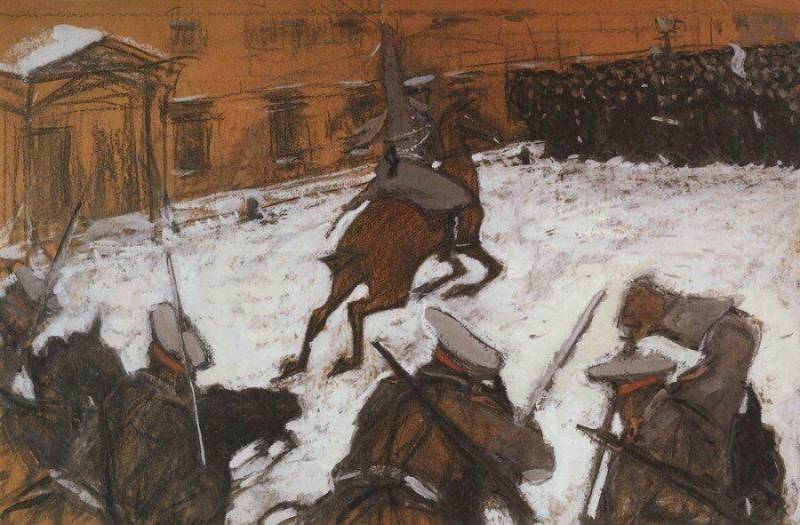
And this is a painting by V. Makovsky:
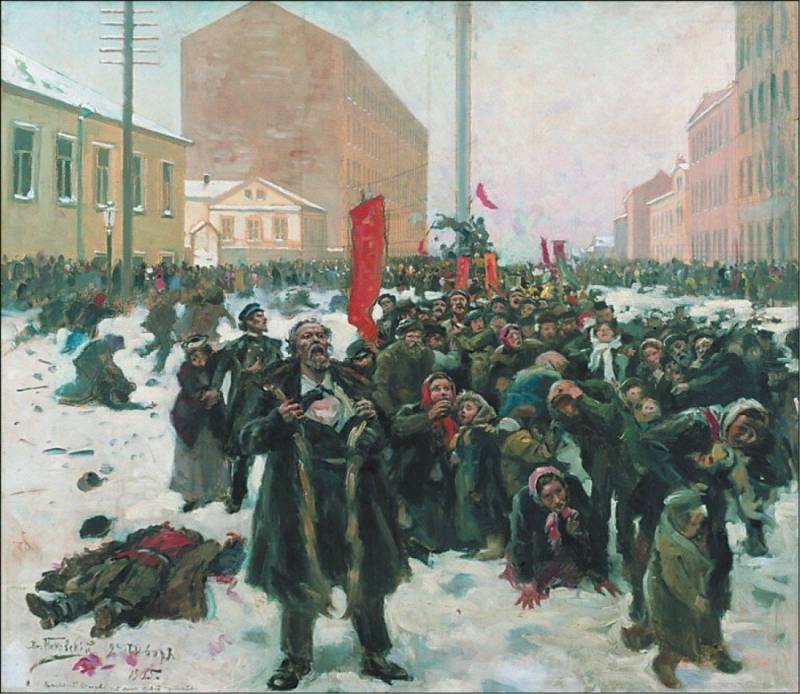
But it was not possible to completely disperse the workers on Vasilyevsky Island; about 1 people seized the armory and began to build barricades, which were destroyed by the end of that day.
Gapon stood at the head of the column of the Narva department of the “Meeting of Workers of St. Petersburg,” followed by about 50 thousand people. From the nearby chapel, four banners, icons and the stole in which Gapon donned were taken. Along with the icons they carried portraits of Nicholas II and a large white flag with a clearly visible inscription: “Soldiers! Don't shoot at the people!
In the book "Stories my life" Gapon recalled:
Gapon, who no longer believed in the success of this action, addressed the crowd:
They met with the tsarist troops at the Narva outpost.

Here Gapon's column was attacked by a squadron of the Life Guards Cavalry Grenadier Regiment. The wounded appeared on both sides: several participants in the procession were wounded by sabers, three soldiers received blows with sticks, and the platoon commander received a cross (!).
Gapon called out to the people walking with him: “Forward, comrades! Either death or freedom! - and then 4 salvos were fired by the infantrymen of the 93rd Irkutsk Regiment. 40 people were killed and injured. Two policemen were among the victims of these volleys.
The demonstrators began to retreat along the ice of the Tarakanovka River. Gapon himself later recalled it this way:
I looked at them again and noticed how lifelessly their hands lay and how streams of blood ran through the snow. Then I understood everything...
Horror overwhelmed me. My brain was pierced by a thought: and all this was done by the “father king.” In this moment of despair, someone took me by the hand and led me to a side street a few steps from the site of the massacre.
There was no point in resisting. What more could I do?
“We no longer have a king,” I exclaimed. Reluctantly I surrendered into the hands of my saviors.”
Gapon, wounded in the arm, was taken away from the square by workers led by Pyotr Rutenberg: his hair was quickly cut off, he was changed into clothes and taken to A. M. Gorky’s apartment. According to eyewitnesses, Gapon was in a state of shock, and when he came to his senses, he sat down to draw up a proclamation, which contained the following lines:
Gorky also wrote his appeal to society, in which he accused Emperor Nicholas II and the Minister of Internal Affairs Svyatopolk-Mirsky of premeditated murder of civilians and called for “an immediate, persistent and united struggle against the autocracy.” He told his friends about Gapon on the evening of January 9:
According to official data, 120 people were killed that day, about 300 were injured, but some researchers bring the number of killed to two thousand people.
On January 11, Nicholas II established the St. Petersburg Governor General, headed by the former Chief of Police of Moscow D. F. Trepov. Arrests of activists of the “St. Petersburg Workers' Meeting” began. Gapon, who was put on the wanted list, managed to travel abroad.
In February, he wrote and sent to the emperor “Letter to Nikolai Romanov, the former Tsar, the former Tsar and the real murderer of the Russian Empire”:
You should have known, you knew it.
The innocent blood of the workers, their wives and young children, forever lies between you, O murderer, and the Russian people. You can never have a moral connection with him again. You are no longer able to fetter a mighty river during its flood with any half-measures, even like the Zemsky Sobor.
Bombs and dynamite, individual and massive terror over your offspring and the robbers of the disenfranchised people, a popular armed uprising - all this must and will certainly happen. A sea of blood will be shed like nowhere else.
Because of you, because of your whole house, Russia may perish. Understand all this once and for all and remember it. It’s better to quickly renounce the Russian throne with your entire house and give yourself up to the judgment of the Russian people. Have pity on your children and the Russian country, oh you, offerer of peace for other peoples, but a bloodsucker for your own.
Otherwise, all the blood that has to be shed will fall on you, executioner, and your associates.
Georgy Gapon.
PS Know that this letter is an exculpatory document for the upcoming revolutionary terrorist events in Russia.
February 20/7, 1905"
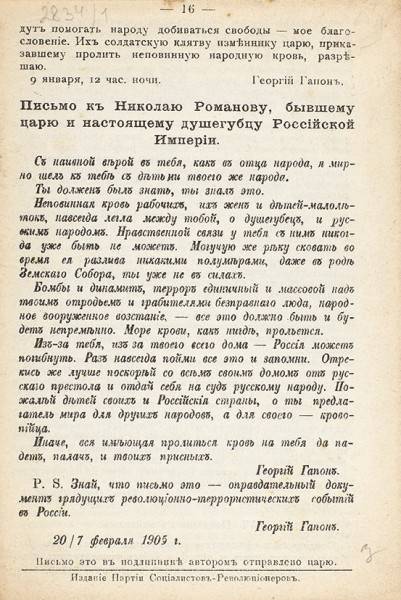
Aftermath
The shooting of a peaceful march in St. Petersburg made a truly terrible impression on society - both in Russia and abroad. Even some tsarist officials were horrified, and the St. Petersburg mayor Fullon submitted his resignation that same evening. M. Voloshin, already quoted, wrote:
And then O. Mandelstam left the following entry in his diary:
Savva Morozov said to Gorky:
Leo Tolstoy wrote:
The newspaper L'Humanité published an article by Jean Jaurès:
The bloody events of January 9, 1905 had another truly fatal consequence for the tsarist regime: they irreversibly changed the Russian army. The soldiers and officers of the regiments who stood in the way of the popular procession later experienced the contempt of the entire Russian society. The reputation of both the army and the guard was completely ruined by the participation of the Semenovsky regiment in the bloody suppression of the Moscow December uprising.
In February 1917, the Petrograd regiments would no longer dare to shoot at workers’ demonstrations. And on February 26, 1917, at 17:1, 500 soldiers of the Life Guards Pavlovsky Regiment - the same one that shot at the procession of workers at the Trinity Bridge on January 9, 1905 - were the first to go over to the side of the revolution and opened fire on the police.
However, Nicholas II and his entourage did not understand this then. As the saying goes, known in different versions back in Ancient Greece, “if God wants to punish, he will first take away reason.”
A delegation of specially selected workers was promptly delivered to Nicholas II, to whom he pompously declared:
He addressed the soldiers of the Semenovsky regiment with the following words:
It seems that he really did not understand that from that moment on he became the first Russian emperor who could not and had no right to hope for the protection of his people. And after his abdication, the newspaper “Russkoye Slovo” published an article with the following words:
Gapon in exile
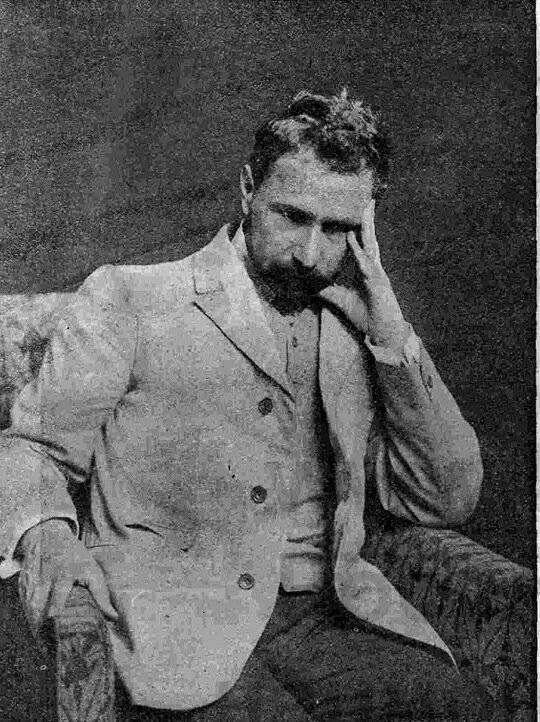
Having left Russia, Georgy Gapon found himself in the rank of a world celebrity. Newspapers wrote about him, and the most prominent figures of the revolutionary movement - Lenin, Plekhanov, Kropotkin - considered it an honor to meet him personally. It is known about Gapon’s meetings with Jaurès, Clemenceau, and Anatole France. In March he was defrocked by a consistory court. Around this time, he gave preliminary consent to join the Socialist Revolutionary Party (SRs).
Among other things, Gapon took part in sending a shipment of weapons to Russia, which was to be delivered by the steamer John Grafton. This was discussed in the article “Evno Azef. The great provocateur's own game".
Gapon was preparing to continue the fight. His conversation with one of the Finnish revolutionaries, Johann Kokk, is typical. In response to his phrase “you had Gapon in Russia, now you need Napoleon,” he said, as if jokingly:
And he also, half-jokingly, said to the socialist and journalist V.A. Posse:
On September 30 (October 12), 1906, Gapon wrote a statement about joining the RSDLP(b).
Return to Russia
After the promulgation of the Manifesto of October 17, 1905, Gapon decided to return to Russia and not only restore the “Meeting of St. Petersburg Workers,” but transform it into an all-Russian organization independent of the government (the All-Russian Workers' Union), and perhaps even into a political party .
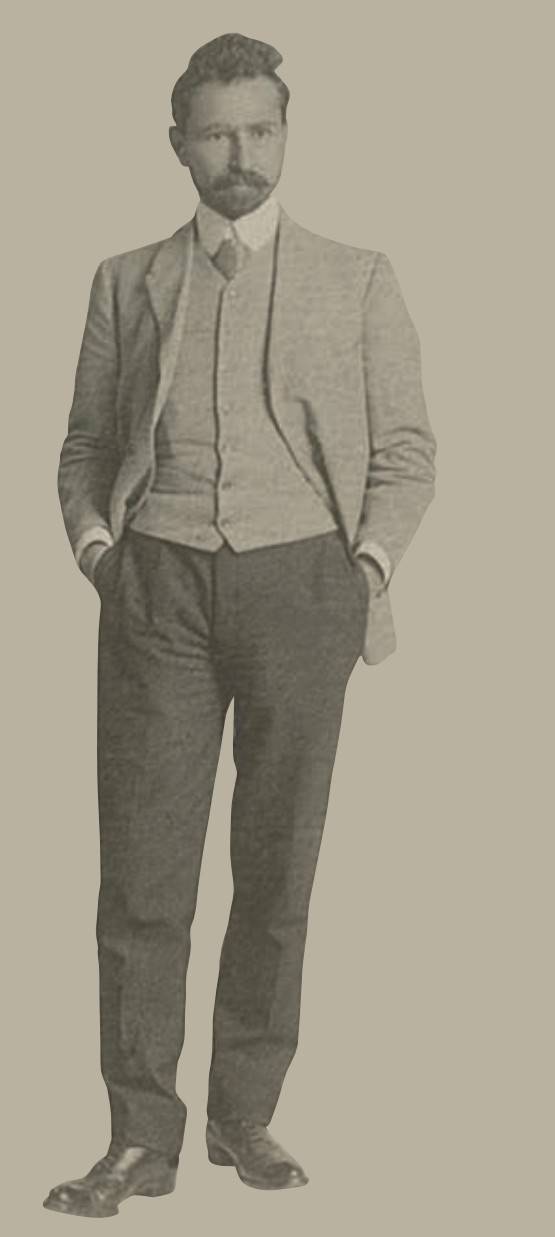
He arrived in St. Petersburg illegally and, through intermediaries, entered into negotiations with Prime Minister S. Yu. Witte, who promised to assist in the restoration of the “Assembly” and even compensate for the financial losses suffered by this organization - 30 thousand rubles. He demanded from Gapon an official renunciation of revolutionary activities and a speech in support of the government course.
Witte wanted to act flexibly, and Gapon was ready to come to an agreement with him. However, the “game” was spoiled by the Minister of Internal Affairs P. Durnovo, who demanded that Gapon no longer be an agent of influence, but a real employee of the Police Department. Gapon refused, and Durnovo, through journalists under his control, began to disseminate information in the press about the former priest’s contacts with Witte, and about the funds that were promised to him by the Prime Minister.
By the way, look at what cartoons depicting Gapon, Witte and Durnovo were published in St. Petersburg at that time:
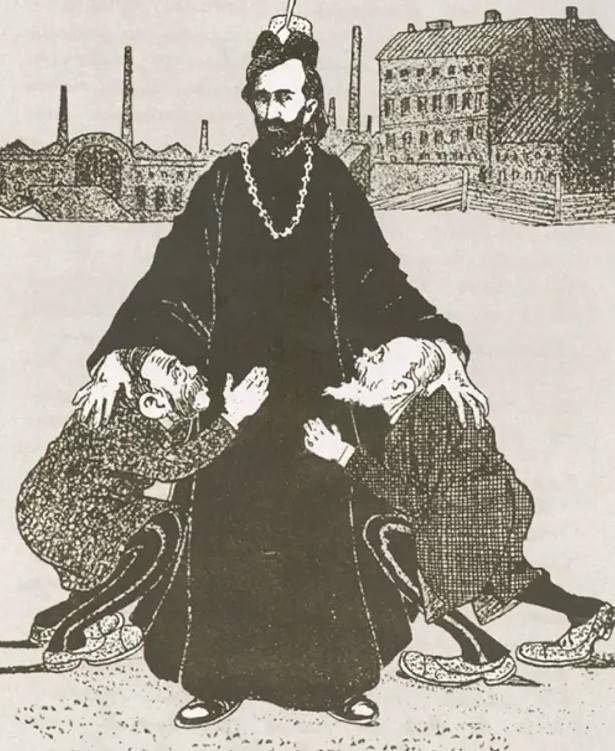
One of his former associates, the former head of one of the branches of the Assembly, Nikolai Petrov, also spoke out against Gapon. In response to rumors about cooperation with the Okhrana, Gapon demanded a public trial of himself.
Death of Gapon
It was rumors about Gapon’s cooperation with the authorities that became the reason for reprisals against him.
The real reason, apparently, was the enormous popularity of Gapon, who claimed to be the leader of the entire revolutionary movement.
On the other hand, many radical opponents of the regime feared that Gapon would actually take the path of peaceful cooperation with the authorities and distract the masses of workers from the “real” revolutionary struggle. This did not suit at all, for example, the head of the Combat Organization of the Social Revolutionaries, Yevno Azef, who, receiving huge funds as an agent of the Security Branch, did not want a significant reduction in funding.
Azef was fully supported by his deputy, the honest and fanatical terrorist Boris Savinkov. It was they who insisted that the Central Committee of the Socialist Revolutionary Party impose a death sentence on Gapon as an Okhrana agent and provocateur.
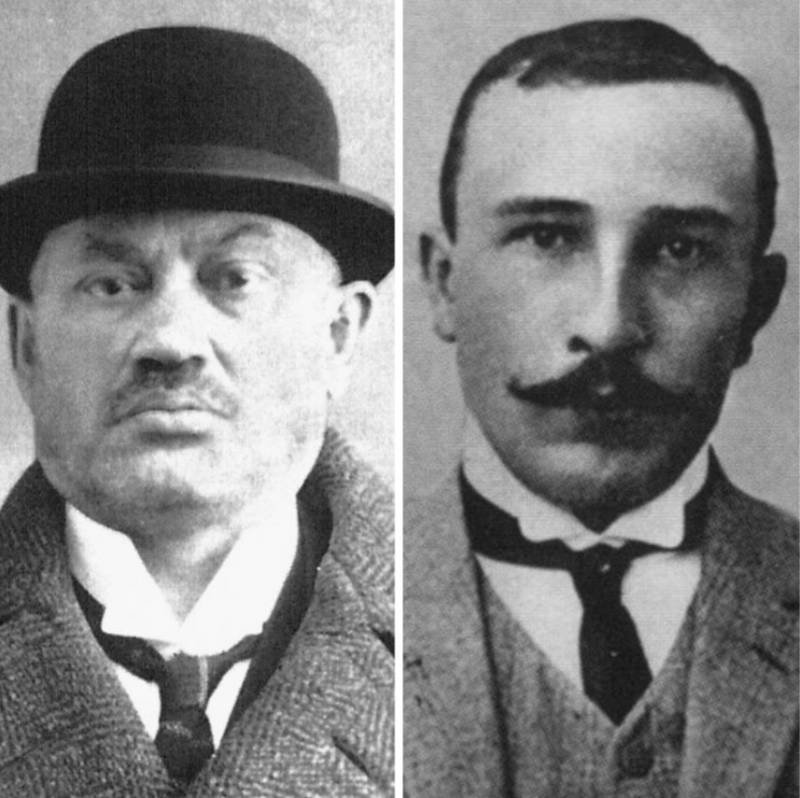
On March 26, 1906, at a meeting of workers, Gapon presented a project for a new organization, which he called the “Program of Russian Syndicalism.” And two days later the “sentence” of the Socialist Revolutionary Party was “carried out.”
It must be said that Gapon was warned about the danger: some said that it came from the Black Hundreds, others advised him to be careful when communicating with the Socialist Revolutionaries. However, Gapon, hoping for his popularity, did not believe in threats.
On March 28, 1906, he went out of town to Ozerki, where he had an appointment with representatives of the Socialist Revolutionary Party. He never returned back.
It was only on April 6 that there were reports in the press that Gapon had gone missing. And on April 16, an official of special assignments at the Police Department, I.F. Manasevich-Manuylov, under the pseudonym “Mask,” published an article in the newspaper “Novoye Vremya” in which he claimed that Gapon was killed by a member of the Combat Organization of the Social Revolutionaries - engineer Pyotr Rutenberg, who had the party nickname Martyn (or – Martyn Ivanovich). Let us recall that it was Rutenberg who actually saved the wounded Gapon at the Narva outpost on January 9, 1905.
A parcel with Gapon's wallet and the key to the fireproof box of the Lyon Credit bank arrived from Berlin to the address of lawyer S. Margolin.
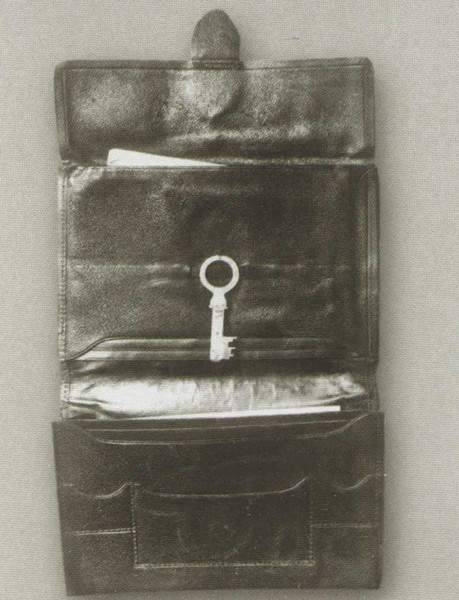
On April 19, the editors of a number of newspapers received anonymous letters saying that Gapon had been killed by the verdict of the “workers’ court” as a “traitor provocateur.”
Gapon’s popularity among the people was so great that the Socialist Revolutionaries did not dare admit to the murder and on April 26 issued an official statement, claiming that “the reports of Novoye Vremya are vile slander.”
And even on July 5 of the same year, Azef refused to Gapon’s killer, P. Rutenberg, to confirm the fact that he acted on the orders of the party. And the Central Committee of the Socialist Revolutionary Party stated that the murder of Gapon was “a private matter of Rutenberg.” The Socialist Revolutionaries recognized the organization of Gapon’s murder only in 1909.
But let's go back to 1906, when on the last day of winter G. A. Gapon suddenly disappeared without a trace.
His body was discovered only on April 30. The owner of the dacha where the murder took place (a certain Zverzhinskaya) noticed that the house she rented was closed and empty. I had to break the locks. The body of the hanged Gapon was found in a room on the second floor. Witnesses identified from photographs the person who appeared in the house that day - it turned out to be Pyotr Rutenberg.
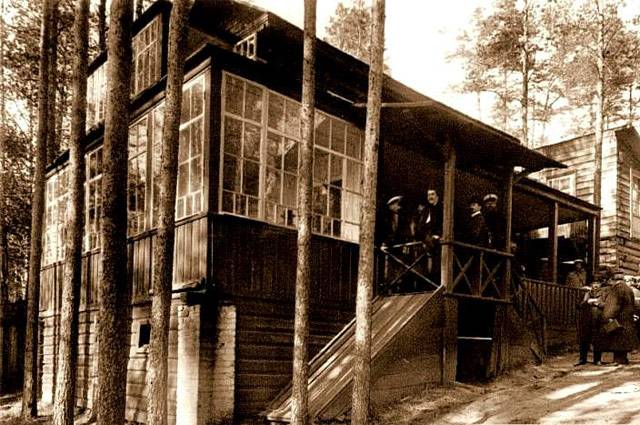
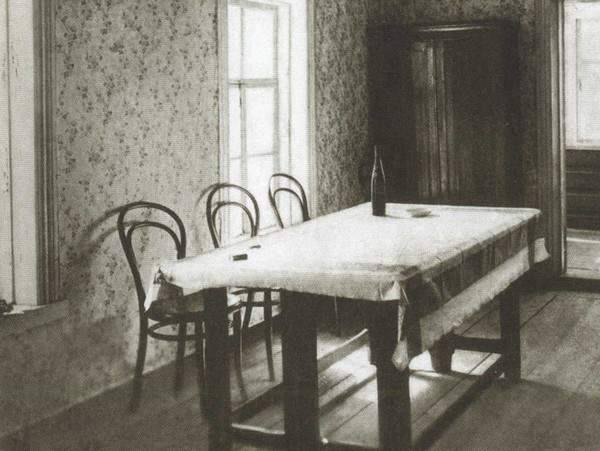
Gapon's death, without any exaggeration, shocked many ordinary people. No one believed that the massacre of him was carried out by revolutionaries; agents of the Tsarist Secret Service were suspected of the murder. The newspapers wrote that Gapon was allegedly going to publish some information incriminating senior officials.
Georgy Gapon was buried at the expense of St. Petersburg workers at the suburban Assumption Cemetery (in Pargolovo) on May 3 in the presence of a correspondent from the newspaper “Novoye Vremya”.
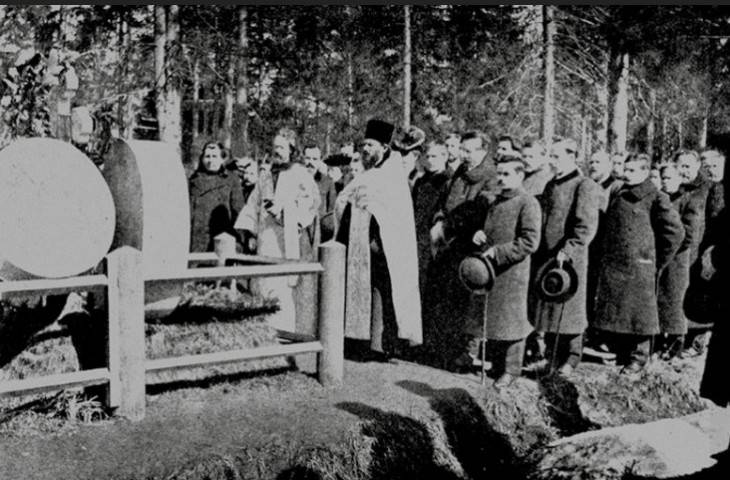
At the rally they sang “You fell a victim in the fatal struggle” and “Bravely, comrades, keep up” and demanded revenge. A wooden cross was placed on the grave with the inscription “Hero of January 9, 1905 Georgy Gapon.”
Police officer Kolobasev in his report gave a list of wreaths laid at the grave:
Then a small metal monument with a white cross and the inscription was placed on the grave:
“Representative of the S.R.F.Z.R. (that is, the Assembly of Russian Factory Workers) Georgy Gapon died at the hands of an assassin on March 28, 1906 at a dacha in Ozerki.”
Later a monument appeared with a cross and the inscription:
Until 1924, wreaths and mourning ribbons appeared on the grave. Then the monument was destroyed, the grave was forgotten and lost.
No one wanted to remove the dacha where Gapon was killed, and it was demolished in 1909.
But what happened in Ozerki on February 28, 1906?
Circumstances of the murder
In 1909, Rutenberg wrote in the magazine “Byloye” that Gapon, who trusted him, himself spoke about contacts with Witte, explaining that money was needed to create a new workers’ organization and that cooperation with the authorities would be used for the benefit of the revolution. Moreover, he claimed that he offered him 25 thousand rubles for information about the impending assassination attempt on the Minister of Internal Affairs Durnovo. This is at odds with his later statements:
What doubts could there be if Gapon really offered him a lot of money for betrayal? Or didn’t he offer it? But it was necessary to somehow explain the murder of a popular labor leader.
One way or another, Rutenberg reported his conversations with Gapon to members of the Central Committee of his party. The head of the Combat Organization, Yevno Azef (who, by the way, himself saved Durnovo from the assassination attempt, receiving 5 thousand rubles for this), with the support of Savinkov, insisted on the “execution of the traitor.” “Carrying out the sentence” was entrusted to Rutenberg himself, who was put in charge of five Socialist Revolutionaries from among the workers.
Rutenberg claimed that during the last meeting they stood outside the door during his conversation with Gapon and were personally convinced of his betrayal. However, this is known only from the words of Rutenberg himself. As for the executors of the sentence, Rutenberg does not even mention their names. And therefore, when preparing an article for the Byloe magazine, Rutenberg had “complete creative freedom.”
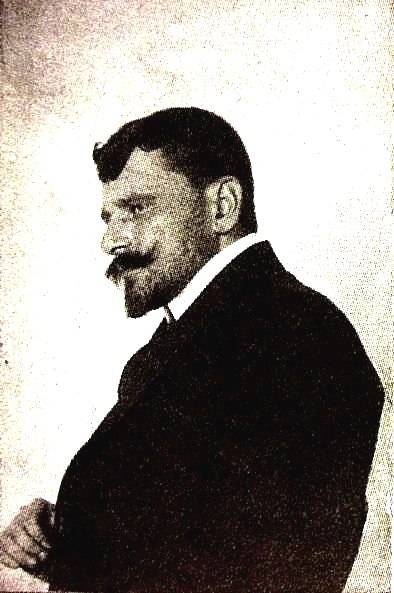
B. Nikolaevsky, in a letter to V. Chernov, written in 1931, mentions students A. A. Dikgoff-Derenthal and Yu. Prokopov among Gapon’s murderers, and Burtsev in 1933 even claimed that Derenthal (by the way, the author of the Russian text of operettas “ Violets of Montmartre" and "Charito") tightened the noose around Gapon's neck.
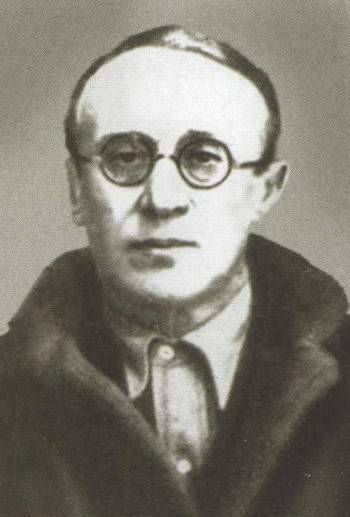
Considering that 25 and 27 years have passed respectively since the murder, these testimonies of people who were not present at the “execution” do not inspire much confidence.
Rutenberg claimed that Gapon's last words were:
Rutenberg allegedly did not take part directly in the murder - he went downstairs. At the time of his death, Gapon was only 36 years old.
Gloomy memories of this murder haunted Rutenberg all his life, and he clearly doubted that he was right. He once said to Savinkov:
After the murder of Gapon, Rutenberg lived in exile, became interested in the ideas of Zionism, and, since he had once converted to Orthodoxy in order to marry Olga Khomenko, on his own initiative he underwent an ancient rite of repentance for apostasy, receiving 39 lashes, the scars of which remained for life.
In 1917 he returned to Russia, proposed to arrest Lenin and Trotsky, was among the defenders of the Provisional Government, spent six months in the Peter and Paul Fortress and was released at the request of Gorky and Kollontai. Created the Palestine Electric Company. During World War II, he became the head of the Vaad Leumi (National Council), the body of Jewish self-government in Palestine. He died on January 3, 1942 in Jerusalem.
Yevno Azef, at whose insistence the decision to kill Gapon was made, after exposure was also sentenced to death by the Socialist Revolutionaries (January 5, 1909).
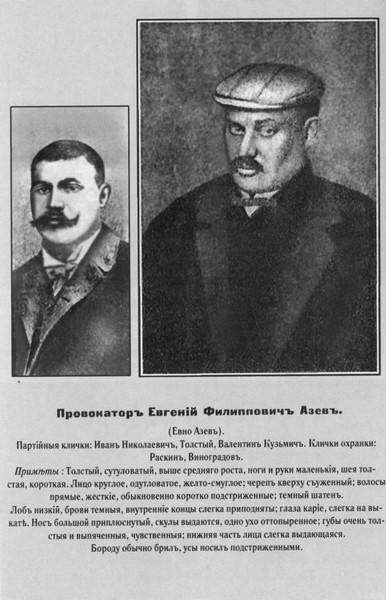
However, he managed to leave for Germany, where he led the life of an unremarkable man in the street. During the First World War, as a Russian subject and anarchist (in fact, a former Social Revolutionary), he spent two and a half years in the Berlin Moabit prison; after his release, he did not live long - he died in April 1918 from kidney failure and was buried in an unmarked grave.
Georgy Gapon, who became a victim of Rutenberg and Azef, who really could have been one of the great figures of the Russian Revolution, still officially bears the undeserved stigma of a bloody provocateur.
Information